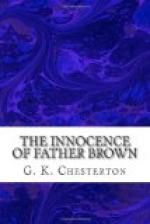“Fourth item. The wax candles, which have to be stuck in bottle necks because there is nothing else to stick them in. Now I wish you to note how very much queerer all this is than anything we anticipated. For the central riddle we are prepared; we have all seen at a glance that there was something wrong about the last earl. We have come here to find out whether he really lived here, whether he really died here, whether that red-haired scarecrow who did his burying had anything to do with his dying. But suppose the worst in all this, the most lurid or melodramatic solution you like. Suppose the servant really killed the master, or suppose the master isn’t really dead, or suppose the master is dressed up as the servant, or suppose the servant is buried for the master; invent what Wilkie Collins’ tragedy you like, and you still have not explained a candle without a candlestick, or why an elderly gentleman of good family should habitually spill snuff on the piano. The core of the tale we could imagine; it is the fringes that are mysterious. By no stretch of fancy can the human mind connect together snuff and diamonds and wax and loose clockwork.”
“I think I see the connection,” said the priest. “This Glengyle was mad against the French Revolution. He was an enthusiast for the ancien regime, and was trying to re-enact literally the family life of the last Bourbons. He had snuff because it was the eighteenth century luxury; wax candles, because they were the eighteenth century lighting; the mechanical bits of iron represent the locksmith hobby of Louis XVI; the diamonds are for the Diamond Necklace of Marie Antoinette.”
Both the other men were staring at him with round eyes. “What a perfectly extraordinary notion!” cried Flambeau. “Do you really think that is the truth?”
“I am perfectly sure it isn’t,” answered Father Brown, “only you said that nobody could connect snuff and diamonds and clockwork and candles. I give you that connection off-hand. The real truth, I am very sure, lies deeper.”
He paused a moment and listened to the wailing of the wind in the turrets. Then he said, “The late Earl of Glengyle was a thief. He lived a second and darker life as a desperate housebreaker. He did not have any candlesticks because he only used these candles cut short in the little lantern he carried. The snuff he employed as the fiercest French criminals have used pepper: to fling it suddenly in dense masses in the face of a captor or pursuer. But the final proof is in the curious coincidence of the diamonds and the small steel wheels. Surely that makes everything plain to you? Diamonds and small steel wheels are the only two instruments with which you can cut out a pane of glass.”
The bough of a broken pine tree lashed heavily in the blast against the windowpane behind them, as if in parody of a burglar, but they did not turn round. Their eyes were fastened on Father Brown.




